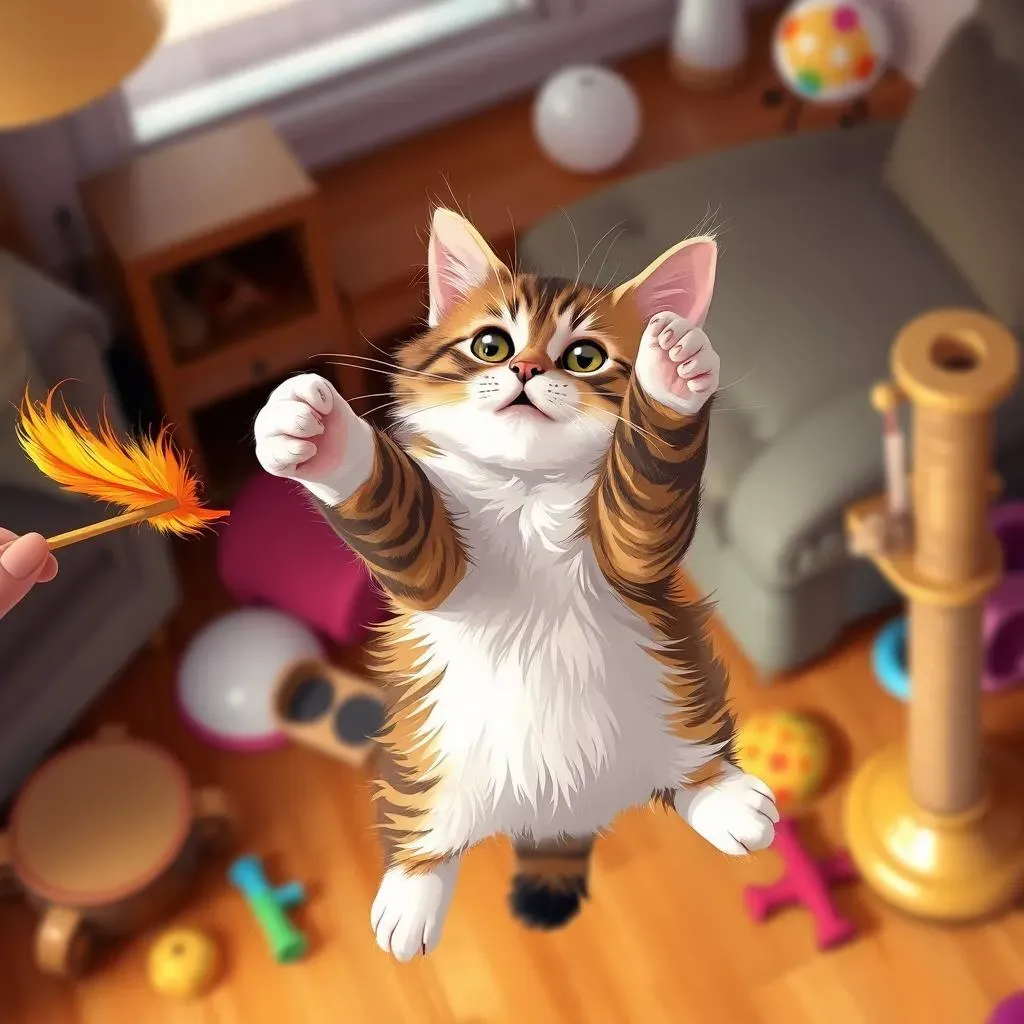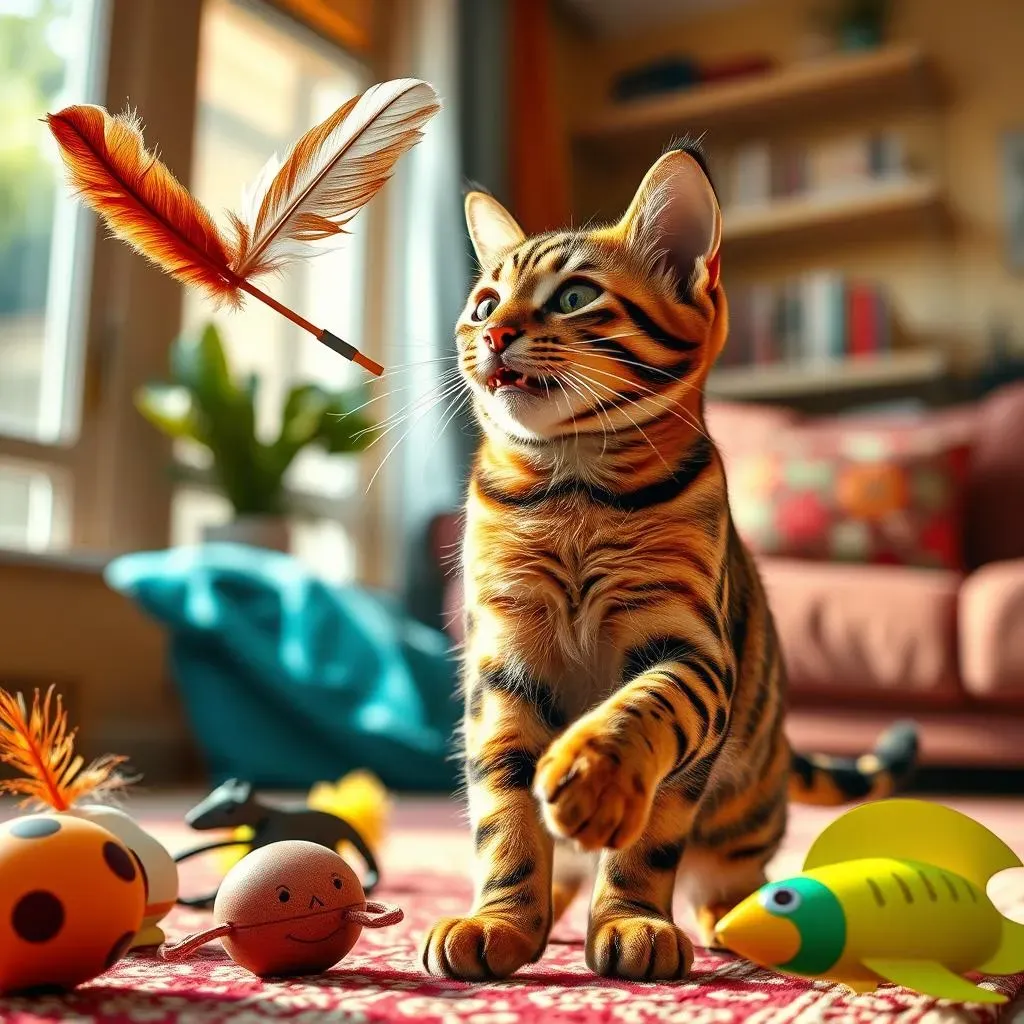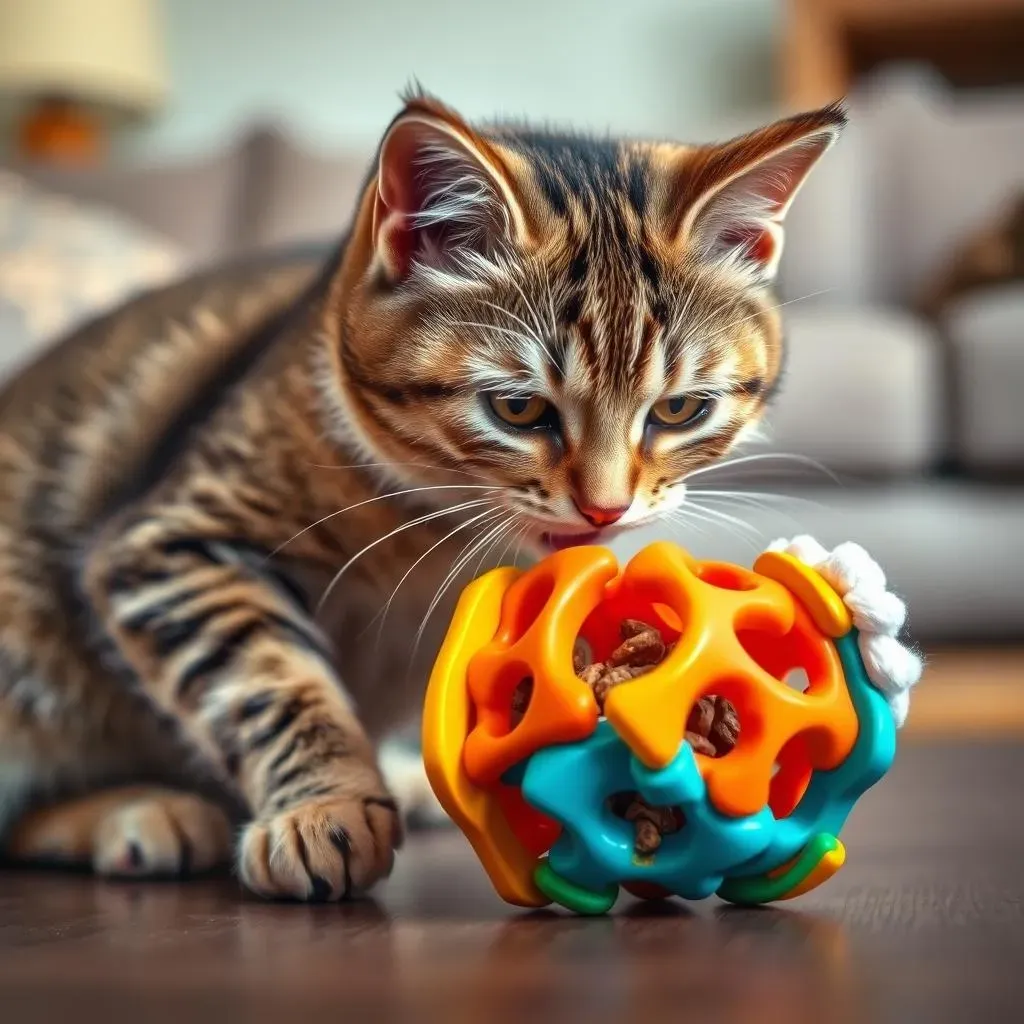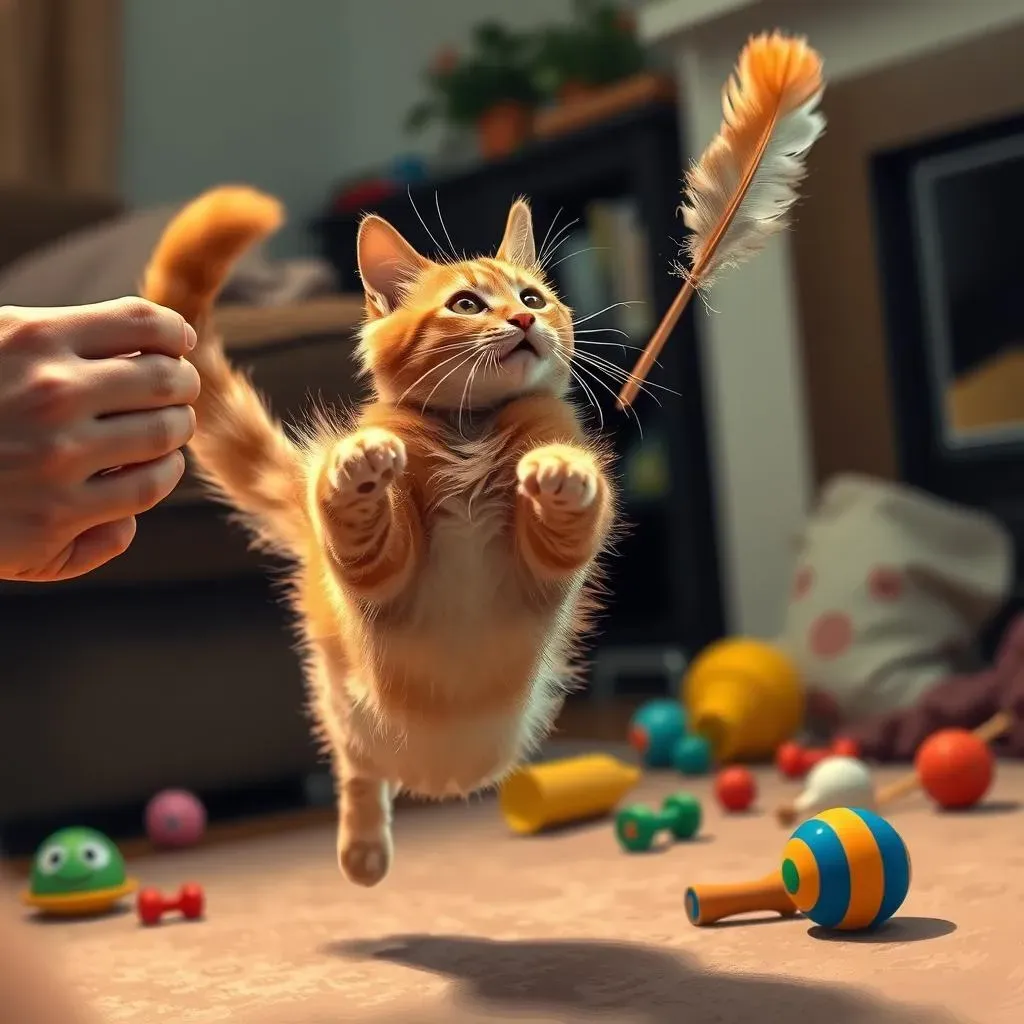Table of Contents
Does your feline friend sometimes act more like a tiny tiger than a cuddly companion? You're not alone. Many cat owners struggle with aggressive behaviors, which can range from playful nips to full-blown attacks. But before you resign yourself to a life of wearing oven mitts, consider this: the key to a calmer, happier cat might just be the right toy. Cats are natural hunters, and when they don't have appropriate outlets for their energy and instincts, they can become frustrated and act out. That's where we come in. This guide is your go-to resource for finding the best cat toys for aggressive cats. We'll explore why cats become aggressive, delve into the types of toys that can redirect their energy, and provide practical tips for engaging your cat in positive play. From interactive wands to durable chew toys and mentally stimulating puzzles, we'll help you find the purr-fect solutions to transform your aggressive kitty into a playful pal. Get ready to discover a world of fun that benefits both you and your feline friend!
Understanding Aggression in Cats: Why Toys Matter

Understanding Aggression in Cats: Why Toys Matter
Before diving into the world of cat toys, it's crucial to understand why your feline friend might be acting aggressively in the first place. Cat aggression isn't always a sign of a "bad" cat; more often than not, it's a symptom of unmet needs or underlying issues. Think of it as your cat's way of communicating – perhaps they're bored, frustrated, scared, or even in pain. Understanding the root cause of aggression is the first step in addressing the problem effectively. Is your cat directing their aggression towards you, other pets, or objects in the house? Identifying the target of their aggression can provide valuable clues.
One of the primary reasons for aggression in cats is pent-up energy. Domestic cats still possess the natural hunting instincts of their wild ancestors, and if they don't have opportunities to stalk, chase, and pounce, they can become restless and aggressive. This is where toys come in! Toys provide a safe and appropriate outlet for these natural behaviors, allowing your cat to satisfy their hunting urges without turning your ankles into prey. The right toys can also help reduce boredom, alleviate stress, and strengthen the bond between you and your feline companion.
Type of Aggression | Possible Causes | How Toys Can Help |
|---|---|---|
Play Aggression | Lack of appropriate play, excess energy | Interactive toys, scheduled play sessions |
Fear Aggression | Anxiety, perceived threats | Safe, comforting toys, gradual introduction to new stimuli |
Territorial Aggression | Protecting territory, competition for resources | Multiple resource locations, toys to distract from perceived threats |
Top Interactive Cat Toys for HighEnergy Cats

Top Interactive Cat Toys for HighEnergy Cats
Alright, now let's talk about the fun stuff: toys! If you've got a high-energy cat with a penchant for aggression, interactive toys are your secret weapon. These aren't your grandma's yarn balls; we're talking about toys that actively engage your cat's hunting instincts and provide a stimulating workout. Think of it as a feline fitness program disguised as playtime! The goal here is to mimic the thrill of the hunt, encouraging your cat to stalk, chase, and pounce in a controlled and safe environment. This not only burns off excess energy but also provides mental stimulation, which can significantly reduce aggressive behaviors.
When choosing interactive toys, consider your cat's preferences. Does your cat love chasing things? A feather wand or laser pointer might be the ticket. Are they more into batting and wrestling? A kicker toy or a toy mouse filled with catnip could be a hit. The key is to find toys that appeal to their natural instincts and keep them engaged for extended periods. Remember to supervise playtime with interactive toys, especially those with small parts that could be a choking hazard. And don't forget to put the toys away after each session to keep things fresh and exciting!
- Feather Wands: Classic for a reason, these toys mimic the movement of birds, triggering your cat's hunting instincts.
- Laser Pointers: Great for high-energy cats who love to chase, but use them responsibly and always end the session with a tangible reward.
- Interactive Mice: These toys often have features like rattling sounds or catnip to entice your cat to play.
- Kicker Toys: Designed for cats to grab and kick with their hind legs, providing a full-body workout.
Best Puzzle Toys for Aggressive Cats: Mental Stimulation

Best Puzzle Toys for Aggressive Cats: Mental Stimulation
Why Puzzle Toys Are a Game-Changer
so your cat's got energy to burn, but what about their brainpower? That's where puzzle toys come in! Best puzzle toys for aggressive cats aren't just about keeping them busy; they're about challenging their minds and providing mental enrichment. Think of it as giving your cat a brain workout, which can be just as tiring (and satisfying) as a physical one. When cats are mentally stimulated, they're less likely to become bored and frustrated, which can lead to a decrease in aggressive behaviors. It's like giving them a job to do, a problem to solve, and a reward for their efforts.
Puzzle toys come in all shapes and sizes, from simple treat dispensers to complex contraptions that require your cat to use their paws and noses to unlock hidden treasures. The key is to find puzzles that are challenging enough to keep your cat engaged but not so difficult that they become frustrated and give up. Start with easier puzzles and gradually increase the difficulty as your cat gets the hang of it. You'll be amazed at how quickly they learn and how much they enjoy the challenge!
"A bored cat is a destructive cat. Puzzle toys keep their minds sharp and their claws off your furniture!"
Choosing the Right Puzzle Toy
With so many puzzle toys on the market, it can be tough to know where to start. Consider your cat's personality and preferences when making your selection. Does your cat love to bat things around? A puzzle toy with moving parts might be a good fit. Are they motivated by food? A treat-dispensing puzzle could be a winner. Also, think about the durability of the toy. If your cat is an aggressive chewer, you'll want to choose a toy made from sturdy materials that can withstand some serious abuse.
Some popular types of puzzle toys include treat balls, which release treats as your cat bats them around; foraging toys, which require your cat to dig and search for hidden treats; and interactive feeders, which slow down your cat's eating and provide mental stimulation at mealtime. Experiment with different types of puzzles to see what your cat enjoys the most. And remember, variety is the spice of life! Rotate your cat's puzzle toys regularly to keep things interesting and prevent them from getting bored.
Puzzle Toy Type | Benefits | Considerations |
|---|---|---|
Treat Balls | Encourages activity, dispenses treats | Can be noisy, may require cleaning |
Foraging Toys | Stimulates natural foraging behavior, provides mental challenge | May require supervision, can be messy |
Interactive Feeders | Slows down eating, prevents boredom | May be difficult for some cats, requires regular cleaning |
Durable and Safe Cat Toys for Aggressive Chewers

Durable and Safe Cat Toys for Aggressive Chewers
Why Durability Matters
Alright, let's get real: if you've got a power chewer on your hands, those cute, flimsy toys just aren't going to cut it. Durable and safe cat toys for aggressive chewers are an absolute must. We're talking about toys that can withstand some serious chomping, biting, and clawing without falling apart into a million pieces. Why is this so important? Well, first and foremost, it's about safety. You don't want your cat ingesting small pieces of plastic, fabric, or stuffing, which can lead to choking, digestive issues, or even surgery. Secondly, it's about value. Nobody wants to keep replacing toys every other day! Investing in durable toys saves you money in the long run and provides your cat with long-lasting entertainment.
When shopping for durable cat toys, look for materials like heavy-duty rubber, reinforced fabric, or thick, braided rope. Avoid toys with small parts that can be easily detached, such as buttons, beads, or plastic eyes. Also, be wary of toys that are glued together, as the glue can weaken over time and pose a hazard. A good rule of thumb is to choose toys that are larger and more solid, making them harder for your cat to break apart.
Top Material Choices
So, what are the best materials for withstanding those mighty jaws? Here's a quick rundown:
- Natural Rubber: It is flexible, durable, and non-toxic, natural rubber is a great option for chewers. Look for toys made from 100% natural rubber to ensure safety.
- Reinforced Fabric: Tough fabrics like canvas or ballistic nylon can withstand a lot of wear and tear. Make sure the seams are well-stitched and reinforced.
- Braided Rope: Cotton or synthetic rope is surprisingly durable and provides a satisfying texture for chewing. Just be sure to trim any loose ends to prevent your cat from ingesting them.
- Hard Plastic: While not as flexible as rubber, hard plastic can be a good option for some chewers. Look for toys made from BPA-free, non-toxic plastic.
Remember, no toy is indestructible, so it's important to inspect your cat's toys regularly for signs of wear and tear. Replace any toys that are damaged or falling apart to prevent accidents.
"Safety first, fun second! Always supervise your cat during playtime and choose toys that are appropriate for their chewing style."
Safety First: Avoiding Hazards
Beyond durability, safety should be your top priority when choosing cat toys. Even the most durable toy can pose a hazard if it's not used properly or if it contains harmful materials. Here are some key safety considerations:
Hazard | Prevention |
|---|---|
Small Parts | Avoid toys with buttons, beads, or plastic eyes. |
Toxic Materials | Choose toys made from non-toxic materials like natural rubber or BPA-free plastic. |
Long Strings or Ribbons | Trim any long strings or ribbons to prevent entanglement. |
Damaged Toys | Inspect toys regularly and replace any that are damaged. |
Also, be mindful of the size of the toy. It should be large enough that your cat can't swallow it whole, but not so large that it's difficult for them to manipulate. Always supervise your cat during playtime, especially when introducing a new toy. And if you're ever unsure about the safety of a toy, it's better to err on the side of caution and choose a different option.
How to Play with Your Cat to Reduce Aggression: Tips & Tricks

How to Play with Your Cat to Reduce Aggression: Tips & Tricks
Establish a Routine
Alright, so you've got the toys, now what? The secret sauce is knowing how to play with your cat to reduce aggression. It's not just about dangling a toy in front of their face; it's about creating a positive and predictable play routine that satisfies their hunting instincts and strengthens your bond. Consistency is key! Cats thrive on routine, so try to schedule play sessions at the same time each day. This helps them anticipate playtime and reduces anxiety and pent-up energy that can lead to aggression. Think of it as their daily dose of feline therapy!
Aim for at least 15-20 minutes of interactive play per day, broken up into shorter sessions if needed. Observe your cat's body language during playtime. Are they engaged and excited, or are they becoming overstimulated and aggressive? If you notice signs of overstimulation, such as dilated pupils, twitching tail, or flattened ears, take a break and give your cat some space. It's all about finding that sweet spot where they're having fun without getting overwhelmed.
"Playtime isn't just fun and games; it's an essential part of your cat's physical and mental well-being. Make it a priority!"
Mimic the Hunt
To truly engage your cat's hunting instincts, try to mimic the natural hunting sequence during playtime. This means starting with a stalking phase, where you slowly move the toy around to pique their interest. Then, move into a chasing phase, where you encourage your cat to chase and pounce on the toy. Finally, allow your cat to "capture" the toy and reward them with praise or a treat. This completes the hunting sequence and provides a sense of satisfaction.
Vary the speed and movement of the toy to keep things interesting. Sometimes move it quickly, sometimes slowly, and sometimes hide it behind objects to create anticipation. Use different types of movements to mimic different types of prey. A feather wand can mimic the flight of a bird, while a toy mouse can mimic the scurrying of a rodent. The more realistic you can make the play experience, the more engaged your cat will be.
Hunting Phase | Description | Tips |
|---|---|---|
Stalking | Slowly move the toy to pique interest. | Use subtle movements, hide the toy partially. |
Chasing | Encourage your cat to chase and pounce. | Vary the speed, create unpredictable movements. |
Capture | Allow your cat to "catch" the toy. | Reward with praise or a treat. |
End on a High Note
Just as important as starting playtime is ending it on a positive note. Always allow your cat to "catch" the toy at the end of the session and reward them with praise or a treat. This reinforces the positive association with playtime and prevents frustration. Avoid abruptly ending the session without allowing your cat to catch the toy, as this can leave them feeling unsatisfied and potentially lead to aggression.
After playtime, put the toys away to keep them fresh and exciting. This also prevents your cat from becoming possessive of the toys and potentially guarding them aggressively. By following these tips and tricks, you can transform playtime into a positive and rewarding experience that helps reduce aggression and strengthens your bond with your feline friend.
- Always supervise playtime.
- Avoid using your hands or feet as toys.
- Rotate toys regularly to keep things interesting.
- Provide a variety of toys to cater to different play styles.
Conclusion: Play Your Way to a Happier Cat
Finding the best cat toys for aggressive cats isn't just about buying a product; it's about understanding your cat's needs and providing them with appropriate outlets for their energy and natural instincts. By incorporating interactive play, puzzle toys, and durable chew options into their daily routine, you can significantly reduce aggressive behaviors and foster a stronger bond with your feline companion. Remember to prioritize safety, rotate toys regularly, and most importantly, have fun! A happy, engaged cat is far less likely to exhibit aggression, making the investment in the right toys a win-win for both you and your furry friend. So, go ahead, unleash the playful side of your cat and enjoy a more harmonious home.